Grafting is a method of joining a part of one plant with another in a way that will cause them to be united and grow as a single unit. Since any mechanical means which achieves proper contact between parts of two different plants may lead to a successful graft, it follows that practically unlimited methods of grafting are available. However, we are concerned here with the simpler and more common means of grafting as shown in Figures I through V.
Grafting of deciduous trees such as apples, peaches, pecans, jujubes and persimmons is normally done during the dormant season, preferably immediately before the tree is due to bud out. Non-deciduous trees such as oranges, loquats, carambolas, may be grafted at any time during the year when new growth is imminent. Avocados are normally grafted late in the winter just before spring growth begins. There are many reasons for grafting, but the most common is probably to propagate a desirable plant by joining small portions on to an established seedling tree. With certain plants, propagation by rooting of cuttings may be more satisfactory but with most fruit trees grafting has many advantages. Since seedlings from desirable fruiting trees frequently results in undesirable fruit, some methods of propagation which preserves the quality of the fruit is necessary. Only plants with close botanical relationship can be grafted successfully; unrelated plants have physiological differences which prevent a union. Viruses also may cause a grafting failure. A successful graft can only be obtained when the scion is oriented as it normally grows. The scion fitted upside down on a root stock will not grow properly.
The established plant or seedling onto which a graft is made is called the root stock. The portion of the desirable fruiting tree being grafted onto the root stock is called the scion. In making the graft, it is important that the scion be protected from drying both before and after joining. This is usually done by covering the exposed surfaces of the scion with a plastic bag or grafting tape, entirely covering the scion. After grafting, it is important that the soil moisture be kept relatively high. If the root system of the root stock is allowed to dry out, grafting will be a failure. It is important that the graft union be a clean, snug fit with intimate contact of the cambium layers in both the scion and root stock. Wrapping the union with grafting tape provides this intimate contact as well as providing support for the scion on the root stock.
SPLICE GRAFT
This method is the simplest way to join scion to root stock. Stock and scion should be of equal thickness, from ⅛" to ½" in diameter. Make a long diagonal cut of equal length on the scion and root stock. Fit cut surfaces together and use grafting tape to hold the parts together as shown in Fig.1. As the scion and root stock are the same size, the cambium layers should match exactly. Allow at least two active buds in the scion wood and cover the entire scion with a plastic bag until the scion buds out. | 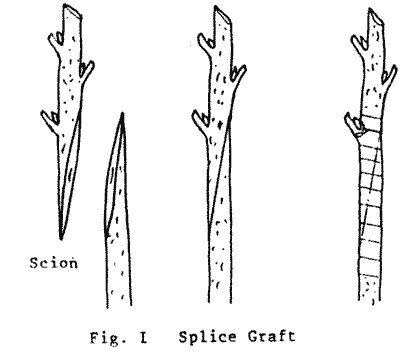 |
|
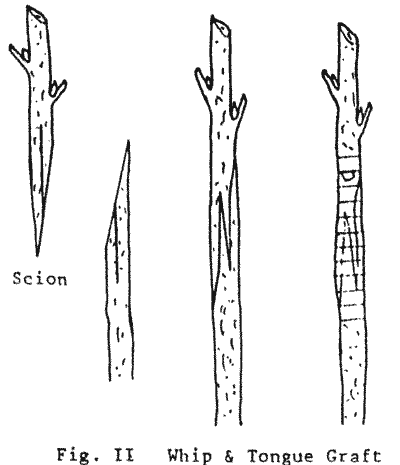 | WHIP & TONGUE GRAFT
This is one of the most commonly used and useful grafts for woody plants. It is used for top-working and producing new plants, primarily on deciduous trees. It works best with stock and scion of equal diameter and less than ½" in thickness. Make a long diagonal cut in both the scion and stock as in the splice graft. Make the second or tongue cut on stock and scion by splitting at the center of the first cut down through the center core of the stem until the split is opposite the base of the first cut. After the tongues are cut, pry open the tongues and insert into each other until they are interlocked as shown in Fig.II. Secure the parts by wrapping tightly with grafting tape. If the scion is smaller than the stock, fit the tongues together so that the outside surface of the stock and one side of the scion are aligned. Cover the entire scion with a plastic bag until the buds sprout. |
|
CLEFT GRAFT
Cleft grafting is a very simple and commonly used grafting method. The scion may be anywhere from ⅛" to 4" in diameter. Cut off the root stock at the right angle in relation to its main axis. Use a knife for small stock and a clefting tool for large stock to split the stock down the center for 1 to 3 inches. If the stock is large, it may be necessary to drive a wedge down the center of the stock to open the split to receive the scion. If the scion is within half the diameter of the root stock, only one scion will be used. If the scion is less than half the diameter of the root stock, two scions will be used. The scion is tapered as shown in Fig. III. Insert the wedge of the scion into the stock so that the cambium layers are in contact on one side or both. The scion should completely fill the split in the root stock so that contact exists along the length of the entire wedge. Wrap the union with grafting tape and cover the entire scion with a plastic bag. | 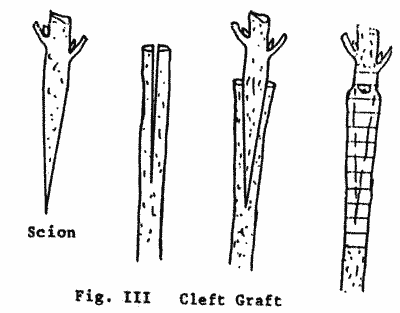 |
|
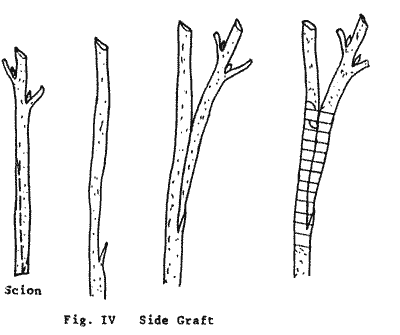 | SIDE GRAFT
The side graft may be used for producing new plants and is very successful on citrus, avocados, carambolas, loquats, etc. It provides for a large surface of cambium contact, and for this reason a union is most likely to occur. Make a rather shallow cut about 1½" to 2" long on the side of the stock, cutting slightly inward as the cut is made. At the base of this cut, make a short inward and downward cut to intersect with the first cut, thus allowing removal of a piece of wood and bark. It is preferable that the stock and scion be relatively the same size. The depth of the cut in the stock will be dependent upon the size of the scion wood. Prepare the scion with a long cut the same length and width as that of the first cut on the stock. Make a short cut on the opposite side of the base of the scion to match that in the root stock. Insert the scion in the root stock as shown in Fig. IV. Secure the scion by wrapping with tape and covering the scion wood with a plastic bag. It is not necessary to top the root stock until the scion buds begin to grow. |
|
APPROACH GRAFT
The approach graft is used to graft together two plants while both remain on their own roots. This is particularly advantageous in grafting plants that are exceptionally hard to graft. It affords the least shock to the scion wood and is almost 100% effective. The scion in this case is usually a limb of a tree growing in the ground. The root stock is normally in a pot which can be tied up to the growing tree so that the scion limb is adjacent to the seedling tree in the pot. A single long, smooth cut is made on adjacent surfaces of the scion and root stock. The cuts are brought together and wrapped tightly with grafting tape. No additional treatment is necessary, with the exception of maintaining the moisture in the potted plant. After the graft union is assured, the top of the potted plant is removed and the potted plant is cut loose from the tree below the graft union as shown in Fig.V. |
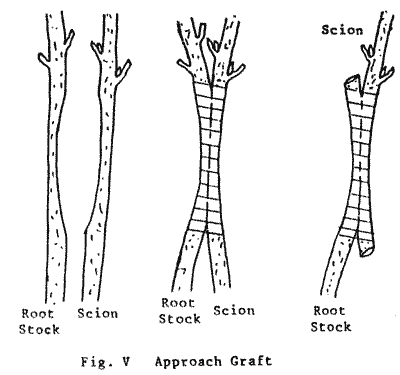 |






